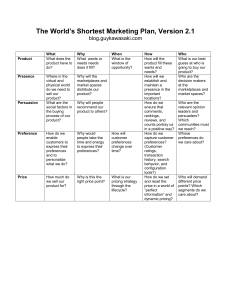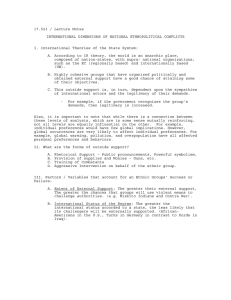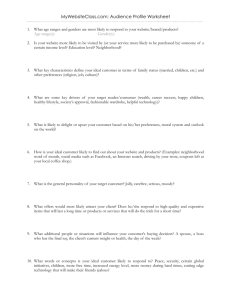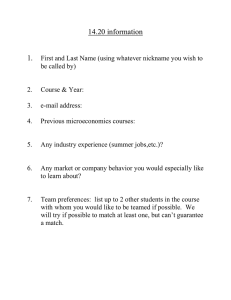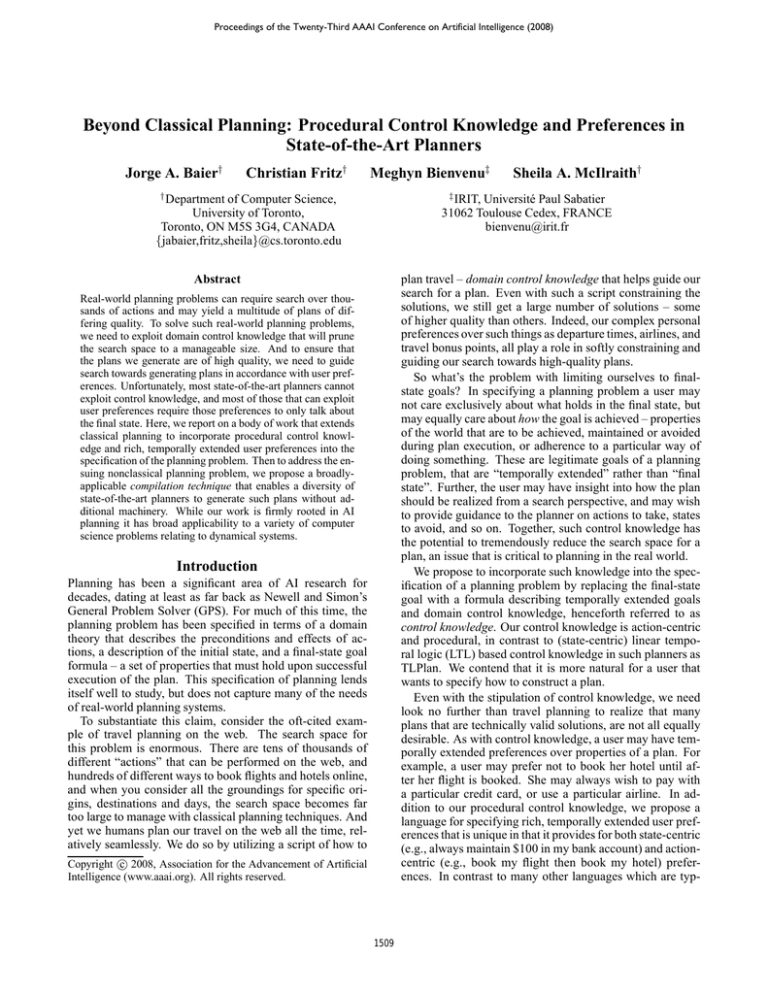
Proceedings of the Twenty-Third AAAI Conference on Artificial Intelligence (2008)
Beyond Classical Planning: Procedural Control Knowledge and Preferences in
State-of-the-Art Planners
Jorge A. Baier†
Christian Fritz†
Meghyn Bienvenu‡
†
Sheila A. McIlraith†
‡
Department of Computer Science,
University of Toronto,
Toronto, ON M5S 3G4, CANADA
{jabaier,fritz,sheila}@cs.toronto.edu
IRIT, Université Paul Sabatier
31062 Toulouse Cedex, FRANCE
bienvenu@irit.fr
plan travel – domain control knowledge that helps guide our
search for a plan. Even with such a script constraining the
solutions, we still get a large number of solutions – some
of higher quality than others. Indeed, our complex personal
preferences over such things as departure times, airlines, and
travel bonus points, all play a role in softly constraining and
guiding our search towards high-quality plans.
So what’s the problem with limiting ourselves to finalstate goals? In specifying a planning problem a user may
not care exclusively about what holds in the final state, but
may equally care about how the goal is achieved – properties
of the world that are to be achieved, maintained or avoided
during plan execution, or adherence to a particular way of
doing something. These are legitimate goals of a planning
problem, that are “temporally extended” rather than “final
state”. Further, the user may have insight into how the plan
should be realized from a search perspective, and may wish
to provide guidance to the planner on actions to take, states
to avoid, and so on. Together, such control knowledge has
the potential to tremendously reduce the search space for a
plan, an issue that is critical to planning in the real world.
We propose to incorporate such knowledge into the specification of a planning problem by replacing the final-state
goal with a formula describing temporally extended goals
and domain control knowledge, henceforth referred to as
control knowledge. Our control knowledge is action-centric
and procedural, in contrast to (state-centric) linear temporal logic (LTL) based control knowledge in such planners as
TLPlan. We contend that it is more natural for a user that
wants to specify how to construct a plan.
Even with the stipulation of control knowledge, we need
look no further than travel planning to realize that many
plans that are technically valid solutions, are not all equally
desirable. As with control knowledge, a user may have temporally extended preferences over properties of a plan. For
example, a user may prefer not to book her hotel until after her flight is booked. She may always wish to pay with
a particular credit card, or use a particular airline. In addition to our procedural control knowledge, we propose a
language for specifying rich, temporally extended user preferences that is unique in that it provides for both state-centric
(e.g., always maintain $100 in my bank account) and actioncentric (e.g., book my flight then book my hotel) preferences. In contrast to many other languages which are typ-
Abstract
Real-world planning problems can require search over thousands of actions and may yield a multitude of plans of differing quality. To solve such real-world planning problems,
we need to exploit domain control knowledge that will prune
the search space to a manageable size. And to ensure that
the plans we generate are of high quality, we need to guide
search towards generating plans in accordance with user preferences. Unfortunately, most state-of-the-art planners cannot
exploit control knowledge, and most of those that can exploit
user preferences require those preferences to only talk about
the final state. Here, we report on a body of work that extends
classical planning to incorporate procedural control knowledge and rich, temporally extended user preferences into the
specification of the planning problem. Then to address the ensuing nonclassical planning problem, we propose a broadlyapplicable compilation technique that enables a diversity of
state-of-the-art planners to generate such plans without additional machinery. While our work is firmly rooted in AI
planning it has broad applicability to a variety of computer
science problems relating to dynamical systems.
Introduction
Planning has been a significant area of AI research for
decades, dating at least as far back as Newell and Simon’s
General Problem Solver (GPS). For much of this time, the
planning problem has been specified in terms of a domain
theory that describes the preconditions and effects of actions, a description of the initial state, and a final-state goal
formula – a set of properties that must hold upon successful
execution of the plan. This specification of planning lends
itself well to study, but does not capture many of the needs
of real-world planning systems.
To substantiate this claim, consider the oft-cited example of travel planning on the web. The search space for
this problem is enormous. There are tens of thousands of
different “actions” that can be performed on the web, and
hundreds of different ways to book flights and hotels online,
and when you consider all the groundings for specific origins, destinations and days, the search space becomes far
too large to manage with classical planning techniques. And
yet we humans plan our travel on the web all the time, relatively seamlessly. We do so by utilizing a script of how to
c 2008, Association for the Advancement of Artificial
Copyright Intelligence (www.aaai.org). All rights reserved.
1509
guidance as to how to plan a trip, the procedure still leaves
some non-determinism. The choices are made through planning with respect to the user’s preferences.
The semantics of Golog was originally defined in the situation calculus. To make such procedures usable by state-ofthe-art planners, we have developed a method for compiling
them to PDDL, the Planning Domain Definition Language,
the input language in the International Planning Competition
(IPC). The compilation is described in the next section.
In this paper we use a language for specifying rich temporal user preferences based on LTL (Bienvenu, Fritz, & McIlraith 2006) which we here refer to as LPP. LPP is one
possible language for expressing preferences, enabling statecentric preferences through LTL and action-centric preferences through the use of the LPP construct occ. Despite our
use of LPP here, our technique is applicable to other preference languages, including IPC’s quantitative preference language, PDDL3 (Gerevini & Long 2005). LPP allows the
user to express temporal properties over states and actions,
and to qualitatively rank such expressions to create preferences. Rankings can be complex and conditional. Finally,
the language allows the user to logically combine several
rankings into one general preference formula. In the first
step of writing a formula, a user specifies properties over
plans, for instance:
ically state-centric and ultimately quantitative, our language
is qualitative, making it more amenable to human elicitation.
We now have a nonclassical planning problem with our
final-state goal formula replaced by a specification of procedural control knowledge and user preferences. Unfortunately, most state-of-the-art planners are not designed to exploit control knowledge. A barrier to this is that much of
it is temporally extended and most planners work towards
achieving a goal, using some measure of progress towards
goal/preference satisfaction. This is however difficult for
temporally extended formulae.
A main contribution of our work is a compilation technique that can take action-centric and/or state-centric control knowledge and preference formulae, and compile them
into a new planning problem that is specified in terms of
final-state goals and preferences. This enables some of the
fastest state-of-the-art classical planners to exploit control
knowledge, and for those that use heuristic search, it provides a means of measuring progress towards satisfaction
of temporally extended goals. Also problem specification
including preferences can be reduced to a basic final-state
goal and preference problems, which all preference-based
planners address, and this again enables heuristic search.
The work presented here is part of a body of research
originally presented in (Baier, Fritz, & McIlraith 2007;
Bienvenu, Fritz, & McIlraith 2006; Baier & McIlraith 2007).
In the sections that follow we briefly overview our specification language and compilation technique.
always((∀h-Hotel, pm)(occ(book(h, pm)) → h = hilton))(P1)
always((∀h-Hotel, pm)(occ(book(h, pm)) → h = delta)) (P2)
IsBusinessTrip → eventually(occ(fileExpenses))
(P3)
where P1 and P2 say that a Hilton, resp. Delta, hotel is
booked, and P3 states that if it is a business trip, at some
point an expense report needs to be filed.
Such properties can be ranked to express preferences over
them in case they turn out to be mutually exclusive in practice. The ranking does not need to be totally ordered. If the
user, for instance, prefers P1 over P2, denoted P1 ≫ P2, but
also has a second independent ranking, these can be combined using disjunction or conjunction. Rankings can also
be conditioned on other properties, for instance
Specification
The specification of our planning problem comprises a domain theory, an initial state, and in place of a final-state goal
we provide control knowledge in the form of a procedure δ,
and user preferences in the form of a preference formula Φ.
Final state goals can be expressed as a special case. In this
section we intuitively describe the Golog language we use
to specify δ, and the language we use to specify Φ.
Golog (Reiter 2001) has classically been used for agent
programming and can be thought of in two ways: a programming language with non-deterministic constructs that
are “filled-in” using planning, or a language for constraining the search space of a planner. Its syntax contains conventional programming language constructs such as if-thenelse and while-loops, together with a set of nondeterministic constructions – (δ1 |δ2 ) for non-deterministic choice
between sub-procedures, δ ∗ for non-deterministic iteration,
and π(x-type)δ(x) for non-deterministic choice of parameter x. Returning to our travel planning example, we can
specify our knowledge of how to plan a trip on the web concisely by the following Golog procedure, slightly abusing
syntax and simplifying the task.
`
(∃f -Flight, pm) occ′ (book(f, pm)) ∧ ArrivalTime(f ) > 12am) :
(∀h-Hotel, pm)occ′ (book(h, pm)) → NearAirport(h)
(P4)
says that if the booked flight arrives after midnight,
we prefer to stay near the airport – occ′ (a) abbreviates
eventually(occ(a)). Details of these more complex formulae and their semantics in the situation calculus can be found
in (Bienvenu, Fritz, & McIlraith 2006).
Computation
Our planning problem consists of a control procedure δ and a
preference formula Φ. Now we propose a compilation strategy to allow state-of-the-art planners to plan in this setting.
A standard approach to planning in the presence of control
knowledge, is to build a search algorithm based on progression. Progression – one of the tools used in planning with
temporally extended control (Bacchus & Kabanza 2000;
Pistore, Bettin, & Traverso 2001) – enables the planner to
prune states from the search space by determining whether
or not a state visited by the search algorithm can be reached
by an execution of the control procedure. The sole use of
[ π(flight-Flight) π(pm-PaymentMethod) book(flight, pm);
if (IsBusinessTrip) then bookLuxuryHotel else
π(hotel-Hotel) π(pm-PaymentMethod) book(hotel, pm)) ]
Using the sequencing construct [a; b], the procedure tells us
to first pick a flight non-deterministically from all available
flights, choose a payment method, and book the flight. After
that, if this is a business trip, we are to book a luxury hotel,
or otherwise find and book a hotel. While providing some
1510
test(¬φ)
progression is not appealing for two reasons. First, it does
not make procedural control available to people who wish
to use procedural control but are bound to using a specific
planner. Second, it does not allow the planner to exploit
techniques that are central to the efficiency of state-of-theart planners, such as domain-independent heuristic search.
Domain-independent heuristics can play a key role in efficient planning in the presence of control knowledge and
preferences. By way of illustration, consider the example in
the previous section. Assume the planner is about to instantiate the action of picking a flight, and furthermore suppose
there is a budget limit of $2,500. Here the planner should realize that it cannot choose an exceedingly expensive ticket,
as that may lead to backtracking when later booking the hotel. In order to realize this, the planner must do some kind
of lookahead computation to determine that there is an unavoidable use of money in the future. This type of computation, which can save a great deal of search effort, is standard in state-of-the-art heuristic planners (such as e.g. FF
(Hoffmann & Nebel 2001)) which usually estimate the cost
of achieving a goal by performing some sort of reachability
analysis. On the other hand, by using only progression, one
cannot extract that type of lookahead information.
To efficiently plan in the presence of control, we have proposed a method to compile a planning instance I and a control procedure δ into a new, classical planning instance Iδ
represented in PDDL, such that a plan for Iδ corresponds
exactly to an execution of δ (Baier, Fritz, & McIlraith 2007).
The key idea of the compilation is that a procedure δ can be
represented as a finite-state automaton (whose size is polynomial in the size of δ) that in turn is represented within
the planning domain. The state of the automaton for δ is
represented by an additional predicate, and the effects and
preconditions of actions in I are modified to respect the execution of the procedure by referring to those new predicates
(see Fig. 1). The resulting instance is amenable to use by any
state-of-the-art planner, including those exploiting heuristics, and because action preconditions are modified, search
algorithms implicitly behave as if they were implementing
progression. We have shown that Golog control knowledge
can be effectively used to improve the efficiency of state-ofthe-art planners in standard benchmark domains.
Now that we can convert any problem with domain control into a classical planning problem, we consider the
case of adding preferences. To plan efficiently for preferences we also need mechanisms to guide the search towards the satisfaction of the preferences. For example, if
a preference establishes eventually(ϕ), we want the planner to choose actions that will lead to the satisfaction of
ϕ. By utilizing the relationship between linear temporal
logic and automata, we have proposed a parametric compilation from temporal LPP preferences into a problem with
non-temporal LPP preferences (Baier & McIlraith 2006;
2007). Those non-temporal preferences refer only to the final state of the plan, i.e. could be interpreted as soft goals.
Interestingly, this enables existing state-of-the-art planning
technology to be exploited to guide the search towards the
satisfaction of the preferences. Most importantly, our translation generates a problem that can be the input to almost
q1
test(φ)
test(ψ
)
q3
a
q4
noop
q6
noop
q2
q7
test(¬
ψ ) q5
b
q8
noop
Figure 1: Automaton for δ = while φ do if ψ then a else b. The
fluent state in Iδ represents the automaton’s state. In Iδ ’s initial
state, state = q1 . Additional goal: state = q8 .
any preference-based planner existing at the moment, since
preferences only refer to the final state of the plan. We have
also developed our own planner, HP LAN -QP, which is able
to plan heuristically with LPP preferences.
Discussion
This paper summarizes and connects research published by
the authors in the last two years. We have shown experimentally that our compilation techniques enable state-ofthe-art planners to plan for various types of goals and preferences, typically obtaining improved performance over existing planners. Details can be found in the original papers.
The results presented here have the potential for broad applicability beyond planning. Planning can be conceived as
a reachability analysis problem, as can a number of other
problems in diverse areas of computer science that relate to
dynamical systems. As such, the research described here is
applicable to a variety of problems. Among these are controller synthesis; requirements engineering; software synthesis, particularly synthesis of component-based software
such as web services; business process and workflow management; and software or hardware verification, all of which
have demonstrated some use of temporally extended hard or
soft constraints, to encode their problem, to control search,
and/or to enforce solution quality.
We substantiate this claim with a few specific examples. Erdem & Tillier (2005) already use planning technology together with domain control knowledge to address the
genome rearrangement problem. They would benefit both
from the speed up provided by our compilation technique
and the ability to express preferences over rearrangement alternatives. Further, Bryl, Giorgini, & Mylopoulos (2006)
have considered the problem of assigning delegations of
tasks to actors in the development of information systems.
They have characterized this task as a planning problem with
preferences. The tasks that can be assigned to the actors in
the system are described procedurally, in terms of decompositions into other sub-tasks, something easily expressible in
our procedural control language. Finally, de Leoni, Mecella,
& de Giacomo (2007) have deployed ConGolog, a concurrent variant of Golog, to model business processes and monitor their execution. We believe our approach could help to
speed up computation in these applications as well.
Despite their common heritage in the very early stages
of AI, agent programming and planning have been largely
studied in isolation in recent history. While the focus of
agent programming has been on increasing expressiveness
to address the needs of real-world applications, in classical
planning the speed of plan generation has remained a central
1511
References
concern. Our work makes a significant step towards reuniting these two branches of research to the betterment of both.
The provision of a compilation technique that enables any
state-of-the-art planner to exploit control knowledge has the
potential for broad impact within the planning community.
Likewise agent programming applications can benefit from
the opportunity to exploit state-of-the-art planners, while the
integration of research on preferences to specify and generate high-quality solutions further benefits both communities.
We now turn our attention to related work, situating our
contributions in the context of previous work. There is a
body of related work in using domain control knowledge to
speed up planning. TLPLan (Bacchus & Kabanza 2000),
the winner of the 2002 International Planning Competition
(IPC), is able to use state-centric temporal logic formulae
to significantly prune the search space. HTN planning (Nau
et al. 1999), is also a successful framework to incorporate
procedural control. A significant difference between those
approaches and ours is (1) these approaches are usually tied
to specific planners and (2) planners such as TLPLan or the
HTN planner SHOP2 (Nau et al. 2003) cannot provide guidance to achieving goals, because the algorithmic semantics
given to the respectively deployed control languages is not
immediately compatible with known successful heuristics.
Also related is work that compiles LTL preferences
into final-state preferences (e.g. Edelkamp (2006)) and
LTL goals into final-state goals (e.g. Cresswell & Coddington (2004)). These approaches, however, are not
parametrized like ours and are therefore more prone to exponential blowups. Finally, Sohrabi, Prokoshyna, & McIlraith (2006) have proposed a Golog interpreter which integrates LPP preferences. Unlike our work, they exploit progression to compute plans.
The future prospects for this work are plentiful. A number of compelling extensions can be easily integrated into
our approach. Among the most compelling is the incorporation of Golog operators, snippets of procedures that can be
used like macro actions in the place of primitive actions during plan construction. This is very natural to do in a number
of domains. Returning to our travel example, one could represent the “book hotel” action as a procedure that evaluates
different prices over a number of web services eventually
booking a hotel. LPP preferences could then refer to the
execution of procedures (e.g. occ(BookHotelProcedure))
and/or impose specific user preferences on particular procedures (e.g. “I’d like to pay for the air ticket using my airmiles
Visa, but the hotel with my low-interest Mastercard”).
Although we have presented our approach as a combination of Golog action-centric control and action-centric and
state-centric LPP user preferences, our compilation technique is sufficiently general to handle a variety of domain
control specification languages and preference specification
languages, including the quantitative preference language
PDDL3, and aspects of the ever-popular HTN action-centric
domain control knowledge (Fritz, Baier, & McIlraith 2008).
Acknowledgements We gratefully acknowledge funding
from the Natural Sciences and Engineering Research Council of Canada (NSERC) and the Ontario Research Fund
Early Researcher Award.
Bacchus, F., and Kabanza, F. 2000. Using temporal logics to
express search control knowledge for planning. Artificial Intelligence 116(1-2):123–191.
Baier, J. A., and McIlraith, S. A. 2006. Planning with first-order
temporally extended goals using heuristic search. In Proc. of the
21st National Conference on Artificial Intelligence, 788–795.
Baier, J. A., and McIlraith, S. A. 2007. On domain-independent
heuristics for planning with qualitative preferences. In 7th Workshop on Nonmonotonic Reasoning, Action and Change (NRAC).
Baier, J. A.; Fritz, C.; and McIlraith, S. A. 2007. Exploiting
procedural domain control knowledge in state-of-the-art planners.
In Proc. of the 17th Int’l Conference on Automated Planning and
Scheduling (ICAPS), 26–33.
Bienvenu, M.; Fritz, C.; and McIlraith, S. 2006. Planning with
qualitative temporal preferences. In Proc. of the 10th Int’l Conference on Knowledge Representation and Reasoning, 134–144.
Bryl, V.; Giorgini, P.; and Mylopoulos, J. 2006. Designing cooperative IS: Exploring and evaluating alternatives. In Proc. of the
Int’l Conference on Cooperative Information Systems, 533–550.
Cresswell, S., and Coddington, A. M. 2004. Compilation of
LTL goal formulas into PDDL. In Proc. of the 16th European
Conference on Artificial Intelligence (ECAI), 985–986.
de Leoni, M.; Mecella, M.; and de Giacomo, G. 2007. Highly
dynamic adaptation in process management systems through execution monitoring. In Proc. of Business Process Management
(BPM), volume 4714 of LNCS, 182–197.
Edelkamp, S. 2006. On the compilation of plan constraints and
preferences. In Proc. of the 16th Int’l Conference on Automated
Planning and Scheduling (ICAPS), 374–377.
Erdem, E., and Tillier, E. R. M. 2005. Genome rearrangement and
planning. In Proc. of the 20th National Conference on Artificial
Intelligence (AAAI), 1139–1144.
Fritz, C.; Baier, J. A.; and McIlraith, S. A. 2008. ConGolog,
Sin Trans: Compiling ConGolog into basic action theories for
planning and beyond. Manuscript.
Gerevini, A., and Long, D. 2005. Plan constraints and preferences for PDDL3. Technical Report 2005-08-07, Department of
Electronics for Automation, Univ. of Brescia, Brescia, Italy.
Hoffmann, J., and Nebel, B. 2001. The FF planning system:
Fast plan generation through heuristic search. Journal of Artificial
Intelligence Research 14:253–302.
Nau, D. S.; Cao, Y.; Lotem, A.; and Muñoz-Avila, H. 1999.
SHOP: Simple hierarchical ordered planner. In Proc. of the 16th
Int’l Joint Conference on Artificial Intelligence (IJCAI), 968–975.
Nau, D. S.; Au, T.-C.; Ilghami, O.; Kuter, U.; Murdock, J. W.;
Wu, D.; and Yaman, F. 2003. SHOP2: An HTN planning system.
Journal of Artificial Intelligence Research 20:379–404.
Pistore, M.; Bettin, R.; and Traverso, P. 2001. Symbolic techniques for planning with extended goals in non-deterministic domains. In Proc. of the 6th European Conference on Planning.
Reiter, R. 2001. Knowledge in Action: Logical Foundations for
Specifying and Implementing Dynamical Systems. Cambridge,
MA: MIT Press.
Sohrabi, S.; Prokoshyna, N.; and McIlraith, S. A. 2006. Web
service composition via generic procedures and customizing user
preferences. In Proc. of the 5th International Semantic Web Conference (ISWC), 597–611.
1512

